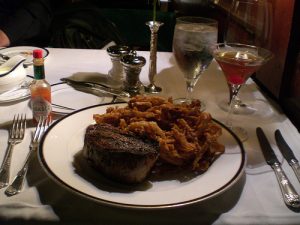 As a hard working member of the customer service industry, I understand and value the act of tipping. I have come to rely on my tips as a source of income, as I work unpredictable hours at minimum wage, with no breaks.
As a hard working member of the customer service industry, I understand and value the act of tipping. I have come to rely on my tips as a source of income, as I work unpredictable hours at minimum wage, with no breaks.
Tipping has a long history. One origin story speculates that “TIPS” is an acronym for “to ensure proper service,” and tips were generally slipped to a waitress prior to the service in order to encourage special treatment. Today I like to believe that “TIPS” means “thanking for proper service,” as the customer is showing gratitude for the experience of dining out.
Listen, no one is asking you to tip at Wendy’s, but when you walk into a restaurant – just one example of a place to tip – you are greeted by a hostess, who ensures that you have proper seating for your comfort. Then a server will come and present you with specials, about which they should be knowledgeable, and then they take your order, fill your drink throughout the night, and ensure the food is of appropriate quality and up to your standards throughout your meal.
A tip does not just thank the server, it goes to the service you received from the moment you arrived hungry, and to the people who cared for you until you left full. Tips are essentially shared throughout the restaurant; a certain percentage goes to the hostess, the bar, the kitchen staff, and the establishment. The server is simply at the forefront, being the friendly, interactive representative of the restaurant and everyone involved.
I don’t believe tips should be mandatory; however, they are a form of encouragement for the server to continue working hard. Tips are also used as a way to non-verbally communicate how the customer felt towards the service. 15% or higher indicates a job well done, whereas anything lower can (and will) be taken as a sign that the customer was unsatisfied with their experience. Without tips, it would be very difficult to target areas for improvement and feel the instant gratification of a customer’s satisfaction.
Some critics (cheap bastards) argue that the 15% gratuity that has become the standard ends up being based on the food that is ordered rather than the service given (lobster bill vs. burger bill). The best way to solve this issue is to simply tip based on service, not bill size. As the old story goes, once upon a time a man placed ten dollars worth of loonies at the end of the table, clearly in view of the waitress, and every time she did something that was not up to his standards, he would remove a dollar. Cruel? Perhaps. Fair? Well, certainly! Yes it may be intimidating, but it makes the aforementioned server work hard for those loons.
Critics of the tipping status quo will also argue that tipping allows management to pay their employees a crappy wage; to that I say do you want your meal to cost more? It’s better to leave it up to the customer’s discretion. Leave tips for good service, and it keeps the servers working to be friendly and welcoming, as well as keeping food prices lower.
Servers are encouraged to learn the menu as best they can, aware that the more information they can provide for their customers, the better dining experience the customer will have. The customer will appreciate the services, and, therefore, they may tip more. This encourages the server to work harder and know more: you wouldn’t ask the cashier at McDonald’s if they could recommend an item on the menu, and if you did ask, you wouldn’t expect much of an answer.
I am encouraged in my everyday life to return the favour and tip those around me: taxi drivers, Starbucks baristas, homeless people who wash things, male escorts, and so on. Overall, tipping is a form of etiquette, a way to say “thanks!” and compel excellent service in the future. Dining out is an experience, and, essentially, that is what you are tipping for: the service, the food, the drinks, the interaction, and the added luxury of not having to clean up a damn thing afterwards. Would it kill ya to leave a few bucks amongst that mess?


